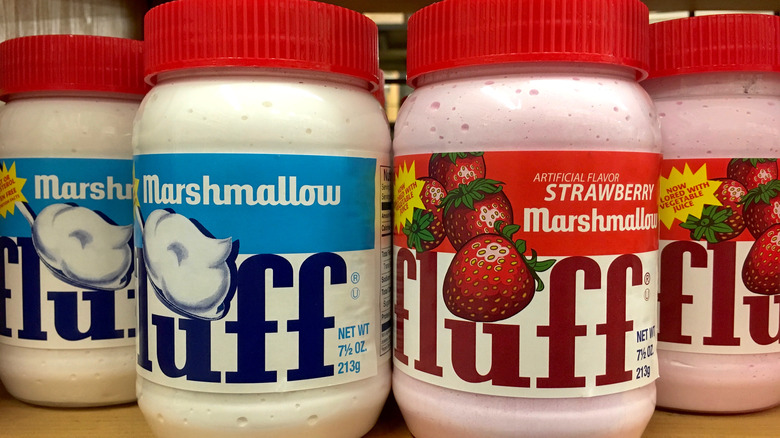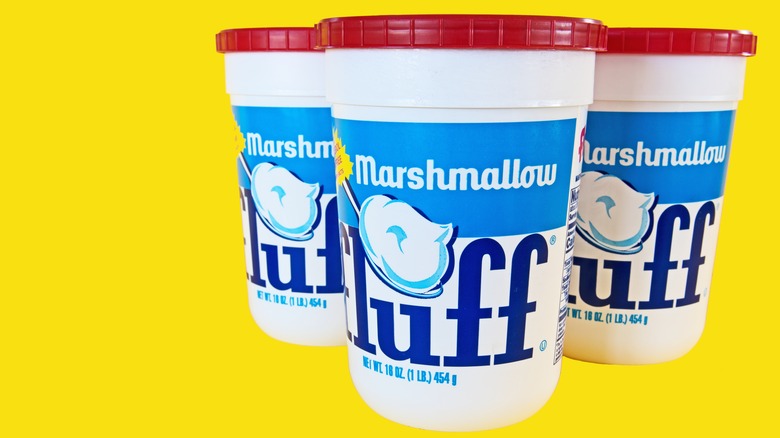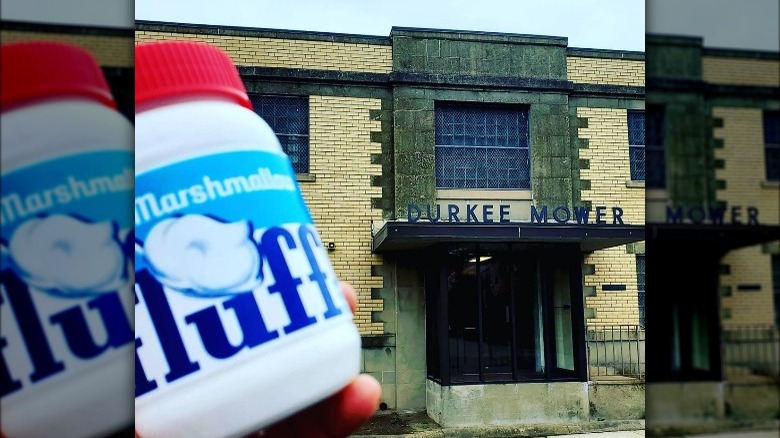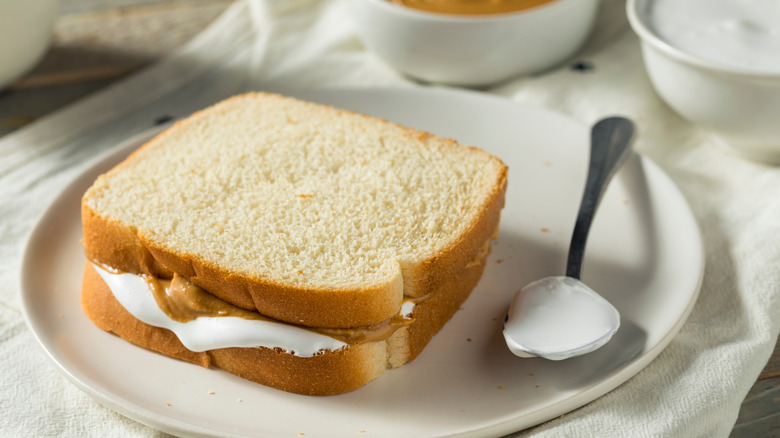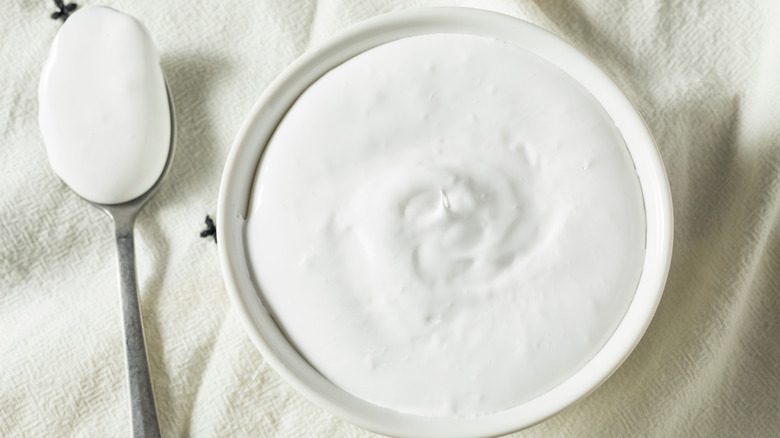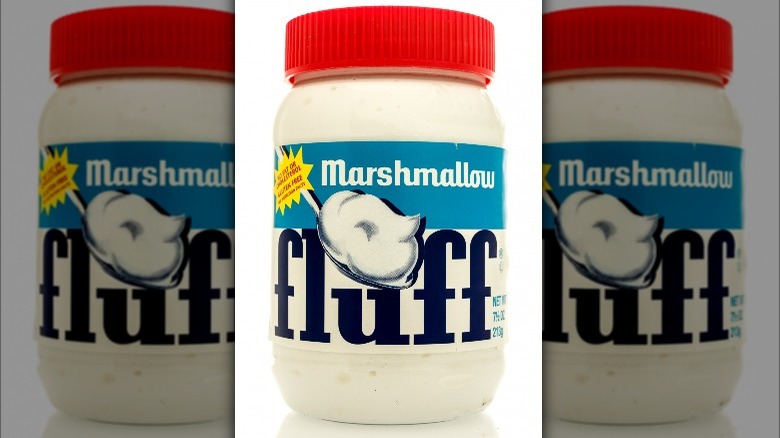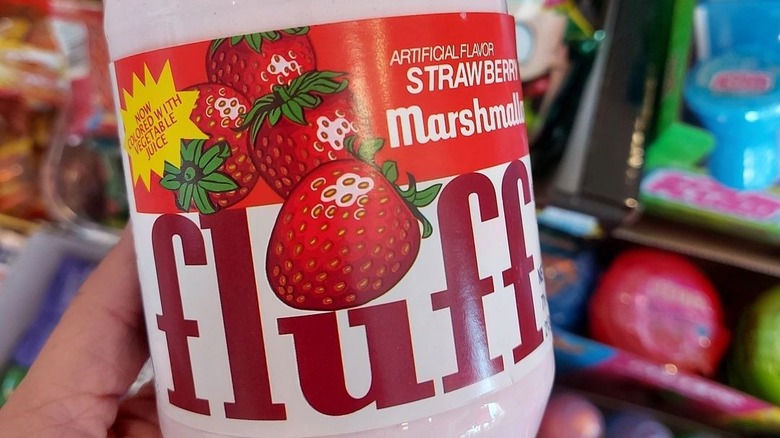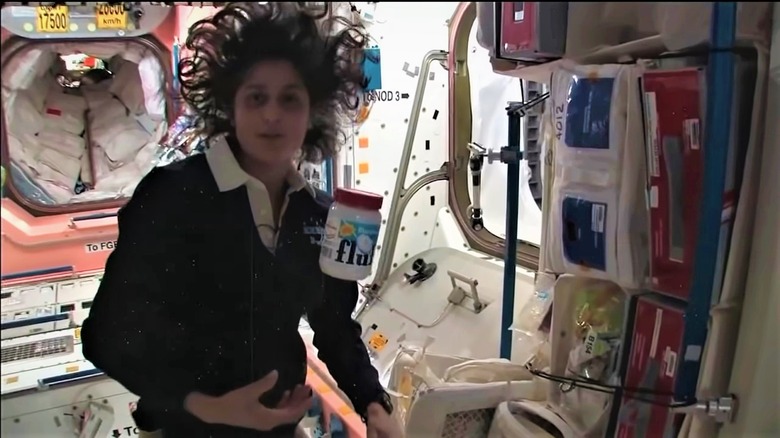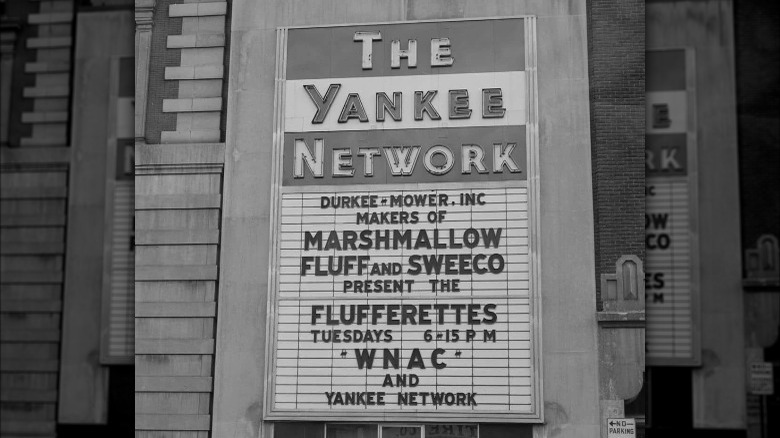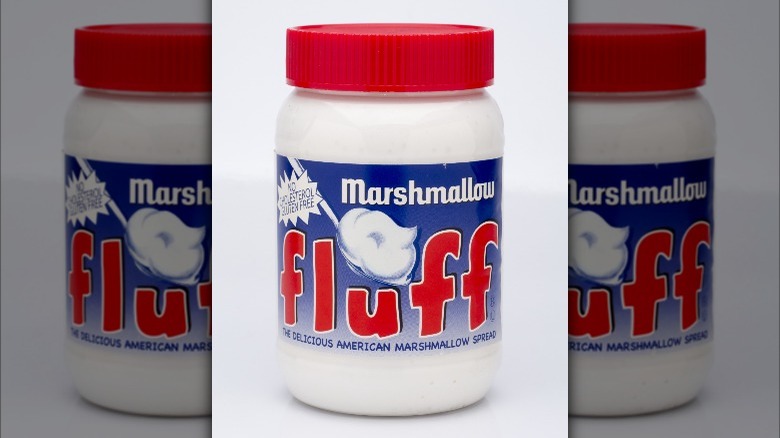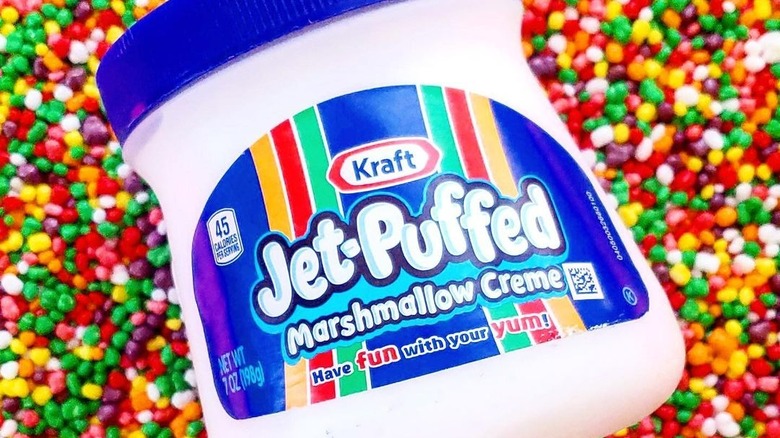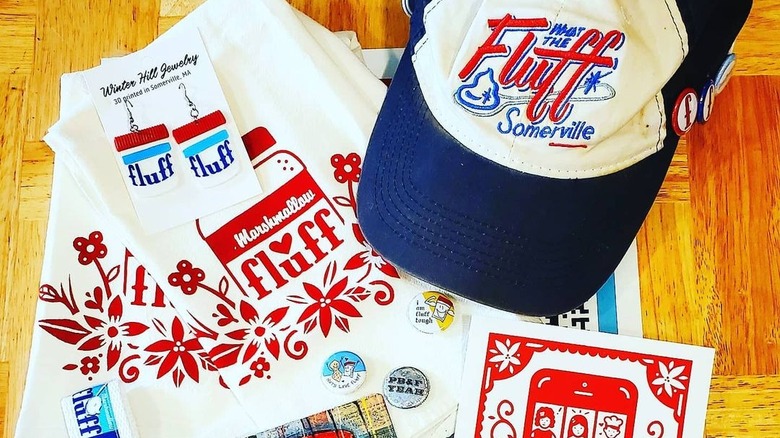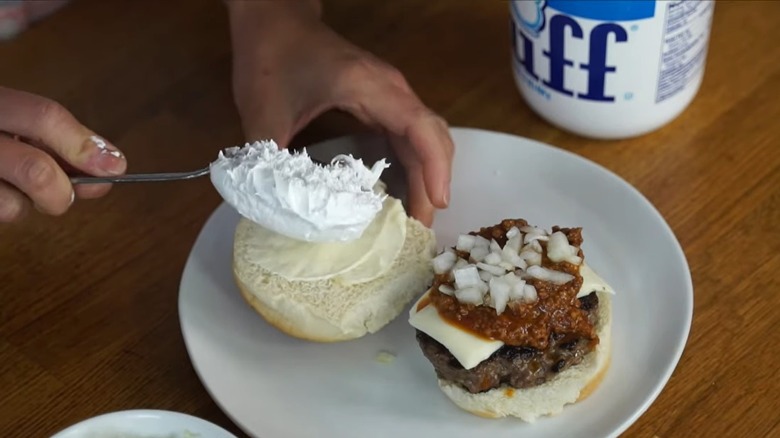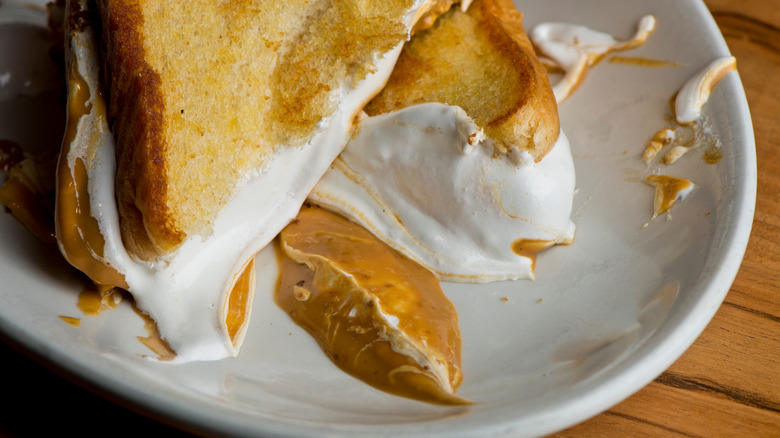The Untold Truth Of Marshmallow Fluff
We may receive a commission on purchases made from links.
Smooth, sweet, and oh-so-sticky, snowy-white Marshmallow Fluff is a New England sensation that's lighter than air but surprisingly heavy on history. While perhaps most acclaimed as one half of the famous fluffernutter sandwich, this gooey jar of dessert-ready delight can stand on its own merits. And while it's similar to the more widely known marshmallow crème, Marshmallow Fluff is indelibly its own thing. It even has an entire book written about it (via Google Books). With only four ingredients and a straightforward, sugary taste, you might think Marshmallow Fluff is simple stuff. But as insubstantial as it seems on the spoon, it has real heft and true staying power, with deep American roots that predate World War I.
It's been cutting-edge in several little-known ways and retains fiercely loyal legions of fans, including several who have enjoyed the down-to-earth spread in space — though according to Yonkers Times, former FLOTUS Barbara Bush had less-than-stellar memories of the aftereffects of gorging on it as a little girl. Whether you have been eating Marshmallow Fluff straight from the jar since you were a kid or still aren't exactly sure what it even is, we've uncovered all the details you need to know about the subject of so many fluff pieces, from how it's made to why you'll never see a chocolate version.
Plus, you might discover some brand new ways to enjoy Marshmallow Fluff — or be inspired to try it for the very first time.
Fluff has been made the same way for over 100 years
Per Marketplace, Marshmallow Fluff is made from four things: corn syrup, sugar, powdered egg whites, and vanillin, a more affordable and stable vanilla substitute (via Scientific American). The Washington Post writes that at the same Lynn, Massachusetts factory where Fluff has been pumped out since 1929, these ingredients are combined in massive mixers and whipped for a closely guarded secret amount of time in order to achieve the signature thick and fluffy texture.
Dependent on granulated sugar and electric beaters as it is, Marshmallow Fluff is clearly a confection that couldn't have been produced at scale in pre-industrial times — but similar recipes can be traced back to at least 1896 when a "marshmallow paste" appeared in Fannie Farmer's "Boston Cooking-School Cook Book." It called for melting down solid marshmallows so they could be spread on cakes. Soon enough, there would be an easier way.
According to What's Cooking America, The Limpert Brothers started selling a different Marshmallow Fluff to commercial businesses like soda fountains and ice cream parlors in 1910, and in 1913, the well-known Whitman's candy company made their own Marshmallow Whip. That same year, per Eater, descendants of Paul Revere concocted Snowflake Marshmallow Créme (later known, far less whimsically, as SMAC). This was the first successful, shelf-stable, spreadable marshmallow substance marketed directly to consumers in New England, but the Marshmallow Fluff that eclipsed them all and has endured until this day wasn't far behind.
Its trajectory was forever altered by WWI
According to Marshmallow Fluff manufacturer Durkee-Mower, the inventor of their product was Archibald Query, who peddled his sweet spread door-to-door in Somerville, Massachusetts beginning in 1917. In a case of very bad timing, sugar shortages and wartime rationing soon began affecting his operation (via The Gleaner). Per Gastropod, "new requirements for federal income tax for small businesses" also started to cramp his style.
In 1920, childhood friends and WWI veterans Fred Mower and Allen Durkee were back in Massachusetts after serving in France, looking to make their fortune. Mower happened to be working in a chocolate factory with Query at the time. Boston.com writes that, uninterested in reviving his door-to-door sales scheme, Query sold his fluffy formula to the budding businessmen for $500. In addition to the newly acquired recipe, the enterprising partners had a single barrel of sugar, a couple of spoons, a few tin cans, and a second-hand Ford between them, which proved enough to grow a thriving business.
The company's official history says that Marshmallow Fluff went for $1 per gallon in those early days when it was briefly called "Toot Sweet Marshmallow Fluff." While the punny name didn't last, the product's popularity spread through word of mouth until the company placed its first newspaper advertisement in 1927. Once it took off, in an uncommonly amicable agreement, the Limpert Brothers and Durkee-Mower simultaneously used the Marshmallow Fluff brand name without conflict (via Artifacts and Talismans).
Marshmallow Fluff is particularly popular in New England
As a product of small-town Massachusetts, it's not surprising that Marshmallow Fluff remains especially beloved in the surrounding areas. As for just how much locals adore it, consider this: NPR reported in 2017 that of 8 million pounds of Fluff made each year, "at least half is sold in New England." In its home region, it's often enjoyed in a fluffernutter sandwich (for the uninitiated, that's roughly equal parts peanut butter and Marshmallow Fluff on white bread). In fact, the fluffernutter has been proposed as the official Massachusetts state sandwich. While that's yet to be ratified, "fluffernutter" was just added to the dictionary in 2021, according to WBUR Boston. Merriam-Webster's newly minted definition does not specify Marshmallow Fluff as part of the creation; instead, it only mentions generic "marshmallow crème" — but purists know better.
Back in 1999, the fluffernutter was name-checked in "The Sopranos," and in 2010, "The Office" actually showed a jar of Marshmallow Fluff on-screen (via Yarn and Entertainment Weekly). But apart from sporadic pop culture call-outs raising its public profile, Marshmallow Fluff has naturally migrated to new areas as people have moved from the northeastern parts of the United States. These days, it's available in other countries as well, including Canada, Germany, Israel, France, and the UAE. That said, if you still can't find it in a store near you (and won't settle for marshmallow crème), you can buy it on the official Marshmallow Fluff site.
Fluff is healthier than you might think
Knowing that Marshmallow Fluff is mostly pure sugar pumped full of air, you might think it's the worst sort of junk food — but while it doesn't exactly provide any important nutritional benefits, it's not as bad as you probably expect. Aside from some sodium, sugar, and carbs, Fluff is almost nutritionally void, with no fat, cholesterol, protein, or fiber either (via Durkee-Mower).
Spoon for spoon, it's less sugary than your average jelly or jam. According to Nutritionix, two tablespoons of jam generally contains about 112 calories and 19.4 grams of sugar. The same amount of Marshmallow Fluff contains 40 calories and 6 grams of sugar, so it's not necessarily a less healthy partner for peanut butter. Marshmallow Fluff is both gluten-free and kosher, and it's made in facilities that are nut-free too, so almost everyone can try it. Since it's made with egg whites, though, it's a no-go for vegans.
It never needs refrigeration but you can freeze it
The Marshmallow Fluff factory is a super-clean site, with tile-covered walls and floors that get scrubbed down every day in a process that takes one and half hours. The company's website notes that "because of the sanitary environment and practices it is not necessary to refrigerate Marshmallow Fluff even though it still contains no preservative of any kind." It is true that unlike so many other mass-manufactured treats — including competing brands of marshmallow crème — Marshmallow Fluff contains zero added preservatives, though the sugar itself acts as a shield against microbial multiplication and bacterial growth.
While it doesn't need to be refrigerated for safety's sake, the company's FAQ (or "Flufferently Asked Questions") notes that storing Fluff in the fridge will make it last even longer at its optimal flavor and consistency. According to Foods Guy, you can also store Marshmallow Fluff in the freezer. The high sugar content will prevent it from ever totally solidifying, so as a bonus, you can eat it straight from the deep freeze for "a nougat-like snack."
You'll never see chocolate Marshmallow Fluff
The standard snow-white version of Marshmallow Fluff is simple and sweet, with a vanilla note just like you'd get from a regular marshmallow. However, a fruity, pale-pink Strawberry Marshmallow Fluff also exists (and currently gets its rosy tint from beet juice). Amazon reviews are mostly positive, and Baking Bites says it "has a bright strawberry punch" that's "a bit more like strawberry candy than fresh strawberries." Those are the only two flavors you'll find in American stores right now, as Durkee-Mower says they discontinued Raspberry Marshmallow Fluff in 2013.
Caramel Marshmallow Fluff is currently available in some European countries (and, at ridiculously inflated prices, sometimes snaggable online). Whether this more sophisticated flavor ever comes to the U.S. market remains to be seen. What's certain is that you'll never be able to buy a chocolate rendition of Marshmallow Fluff, because the manufacturer says the cocoa's butterfat would deflate the fluffiness of the iconic product and prevent it from whipping up to the proper cloudlike consistency.
Fluff has been to the International Space Station
"Out of this world" is a nice if normally hyperbolic way to describe your favorite foods, but Marshmallow Fluff has actually been enjoyed in low Earth orbit (which is technically not outer space, but is close enough for most of us to be suitably impressed). American astronaut Sunita "Sonny" Williams brought a jar of Fluff to the ISS, where, according to a WBUR interview, she had to make her fluffernutters on tortillas in order to avoid free-floating bread crumbs that could compromise sensitive instruments. In a NASA blog post, Williams shared her ideal ratio for coating said tortilla: "a thin spreading of peanut butter, then about ½ inch of marshmallow cream." True fans never skimp on the sweet stuff.
In 2012, a new crew aboard the ISS told NPR that they planned to enjoy Williams' leftover Marshmallow Fluff as part of their Thanksgiving dinner as a topping for their "thermostabilized" candied yams that came vacuum-packed in a plastic pouch.
It used to have its own radio show
In a pioneering move, the Durkee-Mower company harnessed the power of the airwaves to spread the word about Marshmallow Fluff before broadcast advertising was such a common occurrence. The company says that in 1930, they became the sponsor of the Flufferettes radio show, a 15-minute program with live musical numbers and comedic skits that was broadcast on the Yankee Network in New England. Each episode was essentially one long ad but it had to be dressed up as entertainment to comply with noncommercial radio regulations.
Retro Planet writes that in a 13-part radio drama that sounds something like a precursor to "National Treasure" meets the "Little Orphan Annie" subplot in "A Christmas Story," the entertainers hired by Durkee-Mower worked listeners up to this on-air reveal in the final episode: a collection of recipes featuring Marshmallow Fluff. The so-called Yummy Book has since been updated for modern tastes but is still available as a PDF on their website. The "Flufferettes" radio show continued to air into the 1950s, when TV started to pick up steam and became the preferred advertising medium.
The current jar design was crowdsourced
Early Marshmallow Fluff containers were markedly different from the plastic tubs and glass jars we see today. They were made of metal with simply and rather elegantly illustrated labels in fairly muted shades of blue. The bold, bright red-white-and-blue color scheme, charmingly retro fonts, and appealingly chunky depiction of a Fluff-filled spoon still in use today were perfected in the Atomic Age when the company was ready to modernize and make a national name for themselves (via Eater).
In addition to securing the services of an illustrator and graphic designer who also worked, respectively, on packaging for Quaker Oats and GI Joe, Durkee-Mower polled consumers — i.e., New England housewives — to help redesign their packaging, per their official history. In this early example of crowdsourcing, customer feedback called for a jar short enough to fit on a refrigerator shelf, with an opening wide enough to accommodate a tablespoon for scooping out the sticky contents, and some built-in assistance to make opening the lid easier (because once the gooey, gluey Fluff gets into those grooves, it's a challenge to pry it off again). The result was a squat, wide-mouthed glass jar with textured surfaces to help one get a grip when levering off the lid.
While not all present-day Fluff jars have those handy stippled strips, the now-wonderfully old-fashioned labels are still a feast for the eyes.
Marshmallow Fluff is not the same thing as marshmallow crème
Marshmallow crème is a kind of catch-all term that encompasses every sweet, smooth, sticky marshmallow spread — but Marshmallow Fluff is a particular type and a category unto itself (via Budget 101). Other commercial marshmallow crèmes, including the nationally available Kraft Jet-Puffed brand, do not contain egg whites in their ingredients list but do include both cream of tartar and xanthan gum. Per the Marshmallow Fluff FAQ, the Durkee-Mower method of production further sets their spread apart from common marshmallow crème, which "is whipped in a continuous mixing process." By comparison, their own "costly, batch-whipping process" creates a substance in which "the differing results are quite evident." How deliciously shady.
A glance at online recipes for homemade marshmallow fluff (including this aquafaba-enriched vegan marshmallow fluff from It Doesn't Taste Like Chicken) reveals that most contain cream of tartar too, so there's no perfect method of recreating capital-f Fluff at home. Generally speaking, though, you can substitute any of these at a 1:1 ratio for another — but results may vary slightly, especially with homemade versions.
Fluff has its very own food festival
Somerville's What the Fluff? Festival is an annual extravaganza of Marshmallow Fluff merch, culinary experiments, games, and more. As revealed by Fluff expert, festival co-founder, and author Mimi Graney on Gastropod, what started out as a celebration in "a little part of a parking lot" has grown into a "phenomenon" that now attracts "about 10,000 people" every year. At one point, state police came close to shutting down the festival because it was causing so much traffic, but the organizers have since gotten a handle on making things run as smoothly as their namesake foodstuff.
While COVID-19 necessitated a virtual Fluff fest in 2020, in-person attendees can normally enjoy events from the comfortingly standard (live music, local vendors) to the unabashedly silly (grooming contests in which marshmallow goop is used as a styling agent).
Naturally, an array of Fluff-accented foods are on offer. Past creations have included Marshmallow Fluff cocktails, pizza, poutine, barbecue, empanadas, and even singular hors d'oeuvres composed of crackers topped with tuna fish salad, pickles, hot sauce, and a dollop of Marshmallow Fluff.
It's good for far more than fluffernutters
Aside from the stunt snacks (some of which are, allegedly, surprisingly delicious) served at the What the Fluff? Festival, there are far more uses for Marshmallow Fluff than simply schmearing some on sandwich bread along with peanut butter. Marshmallow Fluff makes a lovely hot cocoa topper, is a star ingredient in easy rice cereal treats and no-fail fudge, and can be used as a cake frosting and filling. It's a great choice for whoopie pies and instantly upgrades an ice cream sundae (try thinning it with a little warm water to make a pourable marshmallow topping). It's also The Kitchn's secret ingredient for perfect meringue.
If you want to explore the savory side of Marshmallow Fluff, try it on a burger. Atlas Obscura reports that The Fluff Screamer is a staple at Tony's Lunch in Pennsylvania. Emmeline Cho cooked a copycat version for her Emmymade YouTube channel and had very good things to say! Still not convinced? Try these s'mores cinnamon rolls instead, which use Marshmallow Fluff to lighten up a cream cheese frosting. And don't forget this pro tip: You can toast Marshmallow Fluff under the broiler or with a kitchen torch for extra texture and campfire flavor even indoors (via Foodness Gracious).
Marshmallow Fluff caused a political food fight in Massachusetts
We mentioned that there is a contingent of Massachusetts residents who would like to make the fluffernutter their state's official sandwich, but not everyone is so enamored of the favorite Marshmallow Fluff vehicle or its key ingredient. Former Massachusetts Senator Jarrett Barrios took a public stance against the stuff in 2006 when he discovered that his son's school regularly served fluffernutters for lunch (via Boston.com). Barrios had a good point that providing more nutritious foods in schools should be a priority, but many felt he went too far in villainizing Marshmallow Fluff in particular. He's on the record as saying he was "not sure we should be even calling it a food."
According to NBC News, it was in direct response to his anti-Fluff statement that Rep. Kathi-Anne Reinstein proposed to make the fluffernutter "the official sandwich of the Commonwealth of Massachusetts" and straight-up vowed to "fight to the death for Fluff." It just goes to show that people form fierce allegiances to childhood favorites and often have unshakeable hometown pride even when it comes to seemingly trivial matters. While Marshmallow Fluff is about as far as you can get from health food, it is undeniably sweet, and its fans are clearly stuck on it for good.
